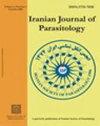Molecular Characterization of Giardia intestinalis and Cryptosporidium spp. Detected in Humans in Ağrı, Türkiye
IF 0.9
4区 医学
Q4 PARASITOLOGY
引用次数: 0
Abstract
Background: We aimed to determine the prevalence of Giardia intestinalis and Cryptosporidium spp. in patients who admitted hospital with diarrhea and to gain information about the transmission of these parasites in Ağrı, Türkiye. Methods: This study included 184 patients who applied to Ağrı-Diyadin State Hospital, Türkiye in 2022. The immunochromatographic card test was used for detection of the G. intestinalis and Cryptosporidium spp. Nested PCR-RFLP analysis of the COWP gene and sequence analysis of the gp60 gene were used to genotype and subtype Cryptosporidium spp., whereas Nested PCR and sequence analyses of β-giardin gene were used genotype G. intestinalis. Results: Of the 184 stool specimens examined, 12 (14.29%) and 7 (3.80%) were positive for G. intestinalis and Cryptosporidium spp., respectively. The Cryptosporidium species were identified as C. parvum belonging to the IId subtype family. The G. intestinalis were identified assemblages A. Conclusion: Assemblage A, which is associated with diarrhea, is responsible for giardiasis and C. parvum IId subtype, often found in sheep, goats and cattle, is responsible for cryptosporidiosis in Ağrı, Türkiye.在土耳其阿格里人体内检测到的肠贾第鞭毛虫和隐孢子虫属的分子特征
背景:我们的目的是测定因腹泻入院的患者中肠贾第鞭毛虫和隐孢子虫属的感染率,并了解这些寄生虫在土耳其阿格里的传播情况。研究方法研究对象包括2022年在土耳其阿格里-迪亚丁国立医院就诊的184名患者。采用免疫层析卡检测法检测肠道革兰氏阳性孢子虫和隐孢子虫属,通过巢式 PCR-RFLP 分析 COWP 基因和 gp60 基因序列分析对隐孢子虫属进行基因分型和亚型,通过巢式 PCR 和 β-giardin 基因序列分析对肠道革兰氏阳性孢子虫进行基因分型。结果:在检测的 184 份粪便标本中,分别有 12 份(14.29%)和 7 份(3.80%)对肠道革兰氏阳性和隐孢子虫属阳性。经鉴定,隐孢子虫属是属于 IId 亚型家族的 C. parvum。肠道孢子虫被鉴定为集合 A:与腹泻有关的 A 组合是造成土耳其阿格里地区贾第虫病的原因,而常在绵羊、山羊和牛中发现的副噬菌体 IId 亚型是造成隐孢子虫病的原因。
本文章由计算机程序翻译,如有差异,请以英文原文为准。
求助全文
约1分钟内获得全文
求助全文
来源期刊

Iranian Journal of Parasitology
PARASITOLOGY-
CiteScore
1.80
自引率
0.00%
发文量
55
审稿时长
6-12 weeks
期刊介绍:
Iranian Journal of Parasitology (IJP) is the official publication of Iranian Society of Parasitology (ISP) launched in 2006. The society was inaugurated in 1994 and pursues the improvement of the knowledge on the parasites and parasitic diseases, exchange of scientific knowledge with foreign societies, publicity activities, and consultation on the parasitic diseases, and intimate relationship among society members.
The main aims of the Journal are: contribution to the field of Parasitology, including all aspects of parasites and parasitic diseases (medical and veterinary) and related fields such as Entomology which may be submitted by scientists from Iran and all over the world.
 求助内容:
求助内容: 应助结果提醒方式:
应助结果提醒方式:


